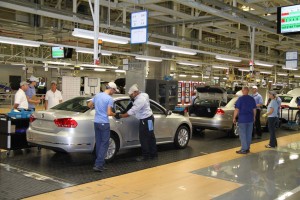
Workers at the new VW plant in Tennessee have had trouble meeting the growing demand for the American-made Passat.
For the first time since the original Beetle dominated the American import market, Volkswagen of America is moving solidly back into the black.
The German maker’s U.S. sales and marketing arm had steadily lost sales, share – and lots of money – ever since Asian rivals like Toyota and Honda became dominant forces in the market back in the late 1970s. In fact, VW’s decline was so severe that the maker came close to abandoning the U.S. in the early 1990s.
But, over the last several years, it has picked up significant momentum with a mix of new products, aggressive marketing – and the addition of its first U.S. factory in decades, in Chattanooga, Tennessee.
That has helped VWoA’s marketing and distribution company to post a profit for two consecutive years. The maker posted its last, rare U.S. profit in 2003, the company acknowledged. Audi, the other part of the Volkswagen Group operations in the U.S., had become profitable back in 2010, according to information supplied at the parent company’s annual press conference in Germany earlier this month.
“Sales and Distribution at Volkswagen of America, which does not include our new factory in Chattanooga, reached break-even in 2011,” revealed VWoA spokesman Carsten Krebs in an e-mail.
The maker has invested $1 billion in the new factory, officials readily acknowledge. But even there, the company is trending in the right direction, Krebs saying that, “We expect our automotive business to break even no later than 2013 on the Volkswagen Group level, driven in particular by products such as the Jetta as well as the new, North American-produced 2012 Beetle and our Chattanooga-built Passat.”
Volkswagen’s manufacturing operations in North America report back to the company’s headquarters in Germany through a separate channel independent of the sales and marketing company. The finance company, which is also profitable, also reports to the company’s headquarters through its own channel.
Every company has its own unique approach to reporting income from its various operations but if the finance company was consolidated with the manufacturing and marketing arm, the company undoubtedly would have been profitable even sooner, Krebs said.
VOA has been on a role of late, scoring double-digit sales gains as well as plaudits for its product line, which is being completely rebuilt to attract American consumers. The maker is hoping to get a real boost next year, with the launch of the next-generationVolkswagen Golf, which will reach dealerships in the U.S. in the first half of 2014.
The seventh-generation hatchback picked up two significant honors this month, being named European Car of the Year at the Geneva Motor, and then picking up the 2013 World Car of the Year trophy during the media preview of the New York International Auto Show.
Much of the momentum has been based on a calculated strategy to promote the diesel side of its line-up. The Volkswagen brand now accounts for 72% of the diesel-powered vehicles sold in the U.S. Sales of diesel-powered cars have been steadily growing as the price of fuel takes a larger bite out of the incomes of American consumers.
The improve performance of the American market is critical for Volkswagen AG’s goal of becoming the world’s largest automaker before the end of the decade.
Martin Winterkorn, VW’s CEO, said earlier this month the automaker expects to invest $5 billion in North America in the coming years. As part of the investment, VW is spending heavily to overhaul its big assembly plant in Puebla, Mexico, where it is building a new engine plant to prepare for the launch of the new Golf next years.
In addition, Audi also is building a new plant in Mexico that is scheduled to open by 2016. The Puebla plant is now the largest automotive assembly plant in North America with the capacity to build 550,000 vehicles annually.

I helped them out with my new Jetta TDI – replacing a Mercedes 240D I’d driven for 24 years. The 240D was still as good as new with 287,000 miles, but a ‘collector’ wanted it, and I really wanted a more modern car. I had looked at the Passat, but a 10 month-old Jetta came in, a stick shift nobody wanted (like my 240D), and its a satisfying little car. I just got 44.9 mpg on a 1,300 mile trip with the cruise set on 82 mph.
VW’s U.S. sales increase is primarily due to lowered prices. The product hasn’t changed much but the prices have dropped so that they are competitive, though they used decontenting to achieve most of the price drop.
The CHAT factory helps lower costs over production in Germany for the few models that VW still imports to the U.S. from Germany. The majority of U.S. models come from Mexico where VW has always enjoyed lower production costs but high educational costs and major quality control issues in their products.
Approximately 10 years ago VWoA was spending in excess of $800 million annually on marketing the VW brand in the U.S. yet they were only selling ~200K units. Lower prices generate first time sales but the overall ownership experience will determine if VW is able to grow it’s market share and sales long term in the U.S.
In actual use the “Blue clean Diesels” that VW sells actually get better than the EPA advertised mpg, because of the U.S. Diesel test methodology used which is designed to discourage consumers from buying Diesels. This of course is bad government intentionally misleading the populace.